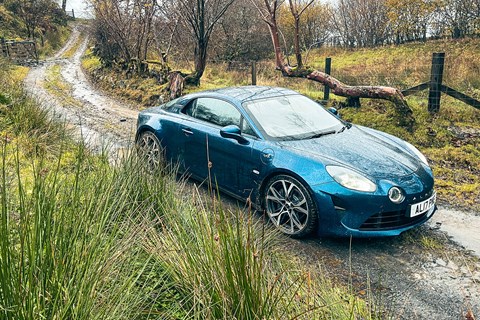► We live with lightweight A110 coupe
► Downsides: cupholders and refinement
► Read month 1 here
Would the Alpine A110 make a good ‘daily driver’? Well, that depends. Because in my book there are two levels of ‘everyday’ car.
On the one hand, there’s a car you can drive to the train station every day for your daily commute – in which case a McLaren 750S would probably make a rather excellent daily driver, whereas a Ferrari F40 really wouldn’t. Sorry, you’d soon get sick of those five-point race harnesses.
And then there’s the every-single-day everyday car – a car that’s not backed up by a companion SUV on the drive, a car that has to do everything, go everywhere and be your domestic workhorse.
And I think it’s important that you know that, in the name of journalistic enquiry, I’m testing the Alpine to this second, higher standard. I’m doing everything in it and using it every day, no matter what the weather.
Probably the most extreme example of my thoroughness was a recent trip to my never-ending Grand Designs project in North Wales. Access to this remote house on the top of a moor is by muddy track, the kind of steep, stony cartway that was popular in the 1700s. Not only that, there was also an amber weather warning for snow that day, which I chose to ignore. Small, rear-wheel-drive sports car in a blizzard? No problem!
The more judgemental of our readers may think I was stupid to set off, given the forecast, but as it happens not a single flake of snow landed during my entire journey, which just goes to show, if we all lived by Met Office weather warnings the whole country would grind to a halt.
I digress. So I reached the foot of the hill without difficulty – more worrying was the track. But I’m pleased to report that, despite not having four-wheel drive or an intake snorkel, the gutsy little Alpine just drove straight up.

The lightness of the all-aluminium A110 always works in its favour, whether you’re driving on a fast B-road or rock-crawling up a gravel track. The kerbweight of just 1102kg means the A110 never needs more than a tickle of throttle to overcome its inertia and get it moving, and the 1.8 turbo engine and seven-speed auto gearbox are beautifully calibrated to allow you to ‘feel’ the drivetrain. It’s a delicate car, one you can tease and feather – it feels intuitive. And it seems pretty tough too.
So I’m impressed with the Alpine as my one-and-only daily driver. On much longer drives it might not be everyone’s cup of tea – sitting in it for three or four hours at a time, the engine drone does start to get in your head.
Hushed Range Rover it is not. But the bucket seats are very comfortable and the upgraded Focal sound system (a £555 option) is solid enough to compensate for the intrusive engine and transmission noise.
The only really substantive issue remains the teeny-tiny boot, which I admit makes this car absolutely useless for a trip to the tip or a big Ikea shop. And the lack of cabin storage. This is actually more irritating because it feels like Alpine could solve it with a bit of clever thinking. There is a handy little slot in the centre console for your phone, so that’s good, but it’s amazing how a lack of door pockets and a cupholder can irritate when you really live with a car day to day.
As I mentioned in the first report on this car, it has the optional Storage pack fitted: a £500 extra that’s essentially just a cargo net and a small lidded box mounted on the bulkhead behind your shoulders. It stops things flying around, but is some way short of being a useful contribution to the car’s practicality.
No wonder the Alpine owners’ club forums are full of cupholder discussions. Seems like 3D printing your own design is the way forward.
Still, I suppose the F40 didn’t have cupholders either.
Read month 1
Read month 2
Logbook: Alpine A110
Price: £54,490 (£59,515 as tested)
Performance: 1790cc turbocharged four-cylinder, 249bhp, 4.5sec 0-62mph, 155mph
Efficiency: 40.3mpg (official), 29.4mpg (tested), 130g/km CO2
Energy cost: 22.8p per mile
Miles this month: 630
Total miles: 2659